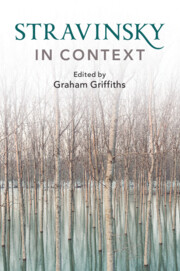Book contents
- Stravinsky in Context
- Composers in Context
- Stravinsky in Context
- Copyright page
- Contents
- Illustrations
- Contributors
- Preface
- Abbreviations
- Frontispiece
- Epigraph
- Part I Russia and Identity
- Part II Stravinsky and Europe
- Part III Partnerships and Authorship
- Part IV Performance and Performers
- Chapter 17 Challenges to Realism and Tradition: Stravinsky’s Modernist Theatre
- Chapter 18 Igor Stravinsky and Ballet as Modernism
- Chapter 19 Stravinsky’s Ear for Instruments
- Chapter 20 Towards a Conductor-Proof Ideal
- Chapter 21 The Pianist in the Recording Studio: Reimagining Interpretation
- Chapter 22 The Legacy of Stravinsky as Recorded History
- Part V Aesthetics and Politics
- Part VI Reception and Legacy
- Recommendations for Further Reading and Research
- Index
- Endmatter
Chapter 21 - The Pianist in the Recording Studio: Reimagining Interpretation
from Part IV - Performance and Performers
Published online by Cambridge University Press: 03 December 2020
- Stravinsky in Context
- Composers in Context
- Stravinsky in Context
- Copyright page
- Contents
- Illustrations
- Contributors
- Preface
- Abbreviations
- Frontispiece
- Epigraph
- Part I Russia and Identity
- Part II Stravinsky and Europe
- Part III Partnerships and Authorship
- Part IV Performance and Performers
- Chapter 17 Challenges to Realism and Tradition: Stravinsky’s Modernist Theatre
- Chapter 18 Igor Stravinsky and Ballet as Modernism
- Chapter 19 Stravinsky’s Ear for Instruments
- Chapter 20 Towards a Conductor-Proof Ideal
- Chapter 21 The Pianist in the Recording Studio: Reimagining Interpretation
- Chapter 22 The Legacy of Stravinsky as Recorded History
- Part V Aesthetics and Politics
- Part VI Reception and Legacy
- Recommendations for Further Reading and Research
- Index
- Endmatter
Summary
On 16 February 1938, Igor Stravinsky and his son, Soulima, recorded Mozart’s Fugue in C minor for Two Pianos K. 426.1 Lasting less than five minutes, the performance filled out the sixth side of Columbia’s album featuring Stravinsky’s Concerto for Two Solo Pianos (1932; 1934/5). It is a singular disc, the only studio recording of Stravinsky playing the music of someone other than himself. Yet its unique existence is mostly ignored or disregarded. Tim Page, in his liner notes from 2003, focused his attention on the Concerto and mentions, dismissively, the Mozart Fugue – ‘thrown in for good measure’.2 Scholars looking at Stravinsky’s performances tend to focus on his role as a conductor, interpreting his own music. This is not surprising given the preponderance of recordings with Stravinsky conducting Stravinsky and the predisposition of scholars to focus on the compositions of artists rather than their identities as performers.
- Type
- Chapter
- Information
- Stravinsky in Context , pp. 187 - 194Publisher: Cambridge University PressPrint publication year: 2020

